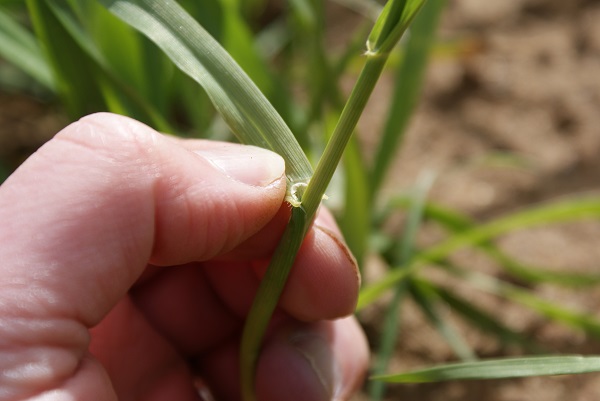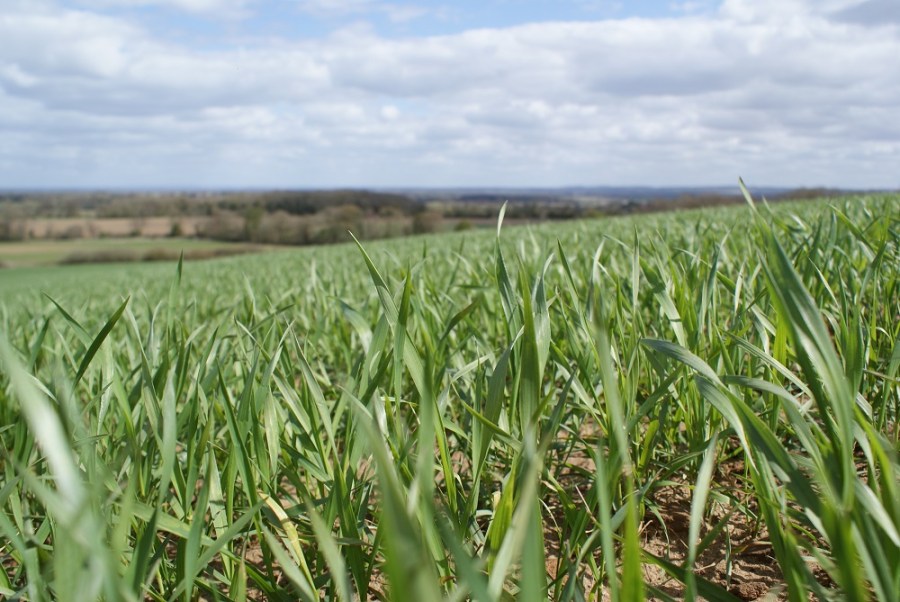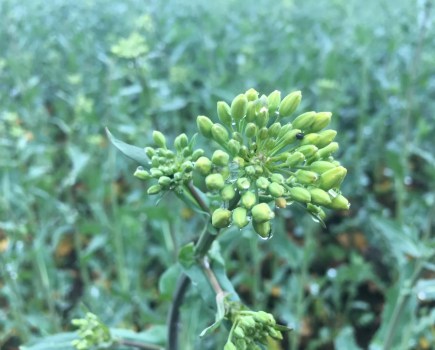Spoilt for choice with new SDHI options? CPM finds out factors to consider when shaping strategies this season (part 1 – see here for part 2).
By Lucy de la Pasture
With fungicide programmes in full swing, the burning question for agronomists is should they be applying one SDHI or two in the course of the programme. The call from researchers in the light of the detection of SDHI insensitive strains is to carefully consider SDHI use and not over-expose the strongest weapon the industry has against septoria. But commercially, two SDHIs in the programme makes sense in a large percentage of situations.
AICC member, Damian McAuley isn’t convinced that dropping an SDHI from the T1 timing altogether is the right way forward.
”I think limiting the pathogen has to be the route for resistance management. If you stop the disease, then you stop resistance developing. We have ample data showing economic responses to SDHIs, even in seasons with lower septoria pressure and with robust varieties,” he says.
“I fully understand the call to limit SDHI exposure but there’s a danger where SDHIs are used at a sub-lethal dose, especially if at both T1 and T2, then we’re raising the selection pressure.”
NIAB TAG senior agronomist Chris Page also has reservations about cutting out an SDHI at T1.

Bill Clark believes the resistant varieties can be more tricky to manage.
“I really don’t endorse the suggestion that two SDHIs in the programme will increase the selection pressure. I think the greater danger could be using an SDHI just once. If we’re using SDHIs where disease is established, I would suggest that is the bigger risk,” he comments.
Bill Clark reasons that part of the argument for an SDHI at the T1 timing is that emergence of leaf three is difficult to identify, even on the main stem.
“This stage might be missed and if you wait for leaf three to emerge on tillers, where leaf emergence is later, then your main target is now exposed and you’re immediately into an eradicant situation,” he explains.
“All too often we seem to be in eradicant situations. In some seasons, there’s been a lack of decent spray days – yet timing is so important. Even products with a double dose of azole are having little effect in extreme eradicant situations,” he adds.
Variety selection
So is there any scope at T1 for making a decision not to go down the SDHI route? Variety selection is one of the important strategies for managing septoria, but resistant varieties can still prove a dilemma when it comes to fungicide choice, believes Bill Clark.
“Azole and CTL mixtures can work at T1 for some more septoria-resistant varieties – the question is whether they work in the harsh reality of commercial farming. The further east you go, probably the more flexibility you have.
“Curiously, I feel the more resistant varieties are the more tricky ones to manage. If you’re growing something like a KWS Santiago the decision is already made for you. You need three or four effective disease-control sprays,” he says.
“With something like KWS Siskin or KWS Crispin, your decisions on when to spray are more difficult – you may not need to start at the T0, delaying your first spray until T1.
“Even at the main T2 timing, doses and partner fungicides are more difficult to judge than with disease-prone varieties. However, it’s clear that such varieties give you more flexibility and reduce risk.”

Damian McAuley isn’t convinced that dropping an SDHI from T1 is the right way forward.
Even if the decision is made to include an SDHI at T1, product choice is probably less important than T2, adds Bill Clark.
“All are pretty good septoria protectants. The decision is more on the specific susceptibility of the variety. I do think there’s a case where we could look at reducing recommended rates of SDHI co-forms at T1 and T2 or limiting them to a single timing in our most septoria-resistant varieties.
“If you look at untreated trials with varieties, such as KWS Siskin, then the difference between treated and untreated can be as little 0.75t/ha. Such varieties are offering something in reducing selection pressure,” adds Bill Clark.
“These very robust varieties are providing some flexibility in the programme, possibly even allowing for an azole + CTL approach at the T1. We don’t want to take any risks when it comes to septoria getting established, but azoles are still good protectants and, when used in conjunction with a robust variety, can allow growers to limit SDHI use to the T2 timing.
Slows disease development
Another point to bear in mind is that resistant varieties are slowing the development of the disease, comments Bill Clark.
“It means even if there’s a small delay in fungicide timing, then you’re still in a protective situation. It’s where SDHIs are exposed to curative situations that the greater risk occurs, which we clearly need to avoid,” he stresses.
Chris Page believes resistant varieties probably add more in terms of flexibility with spray timings than to resistance management.
“I think variety selection has a role, but I’m not convinced that it’s really adding much in terms of resistance management. I see it as more of an application flexibility benefit,” he says.

Attention to spray timing is all important but tricky to identify correctly.
“Under ideal conditions septoria’s latent phase could be as short as 14 days. A large wheat area all hitting GS39 in a narrow window is a huge risk. Slowing the latent phase by a few days can only be of benefit. But I don’t see variety resistance as a chance to reduce rates,” he qualifies.
Damian McAuley believes a strategy based on azole + CTL + strob still has a place at T1 in certain situations.
“Where you have a robust variety – say a disease rating of 7 for septoria, drilled late and in a dry season – then it’ll still give you sufficient control, but timing is critical and you need to be on top of septoria at GS32. But if you have a susceptible variety and favourable conditions for septoria, then an SDHI is the only option.
”But I can understand why some would ‘default’ to an SDHI. Weather volatility after application and a grower’s ability to get around their wheat area make a strong case for SDHI,” he says.
“It’s viewed as the safer option. And the cost difference isn’t always that great. So for an extra £10/ha, not only does a grower get a more potent product but simplicity with many being co-forms.”
Azoles give value
Both agronomists are keen to point out the value that azoles still bring to the programme, in spite of their much-reported decline in efficacy over recent years.
“Azoles are still good broad-spectrum products. Septoria may be your main target but eyespot and rusts can’t be discounted and in terms of the stem-based complex, there isn’t any better azole than prothioconazole,” says Damian McAuley.
“Azoles remain important, not just as safeguards for SDHIs but also for their broad spectrum of control. Septoria and yellow rust dictate programme strategies, but mildew, eyespot and fusarium can also threaten,” adds Chris Page.
“You may only see an eyespot outbreak once in every three or four years, but you have to be on the lookout for it. If you have eyespot on the stem base post GS32, then you’re in trouble,” he adds.
Managing azole resistance is just as important as managing SDHI resistance, believes Damian McAuley.
Robust dose
“If we see a further decline in azole sensitivity where do we go? Azole stacking isn’t the answer but varying actives throughout the season will help,” he comments.
Lack of dose flexibility as a consequence of resistance is one of the issues both agronomists highlight.
“We don’t really have dose flexibility anymore, even with straights. Azoles and SDHIs are reliant on each other for protection and we’re up at high rates already. Many are being used at 80% dose, and sometimes higher. The only timing where we genuinely have dose flexibility now is T3,” says Chris Page.
“An SDHI that has a low dose of azole really needs an azole top-up in the form of a straight, but that’s inconvenient and expensive. It’s better to opt for a product that delivers a robust dose of azole in the first place,” adds Damian McAuley.
Bill Clark feels uneasy about the availability of straight SDHIs in the marketplace and warns that they need careful stewardship and partnering with an adequate dose of azole.
“If you’re in a relatively low-septoria pressure situation or have a resistant variety, a half rate of azole as a partner to the SDHI might be sufficient. But that is very much the exception rather than the rule,” he comments.
Damian McAuley says his programmes will be decided on the weather, varietal resistance and canopy.
“My strategy is likely to have two SDHIs at its heart, but which ones will be determined by the risk. I do like prothioconazole at the T1 timing because of its eyespot activity, so it would suit Aviator (bixafen+ prothioconazole), Ascra (bixafen+ fluopyram+ prothioconazole) or a Proline + Vertisan (penthiopyrad) mix, and possibly coming in with Adexar (epoxiconazole+ fluxapyroxad) at the flag leaf.
“But if rust is a concern early in the season, then an epoxiconazole-based T1 or a proven rust-acting SDHI such as Elatus (benzovindiflupyr+ prothioconazole) will be planned with a prothioconazole-based T2 to follow. If curative activity is needed, I’ll be calling upon the newer products like Ascra or Elatus,” he says.
Read our experts’ thoughts on T2 fungicides here and in the April issue of CPM.




